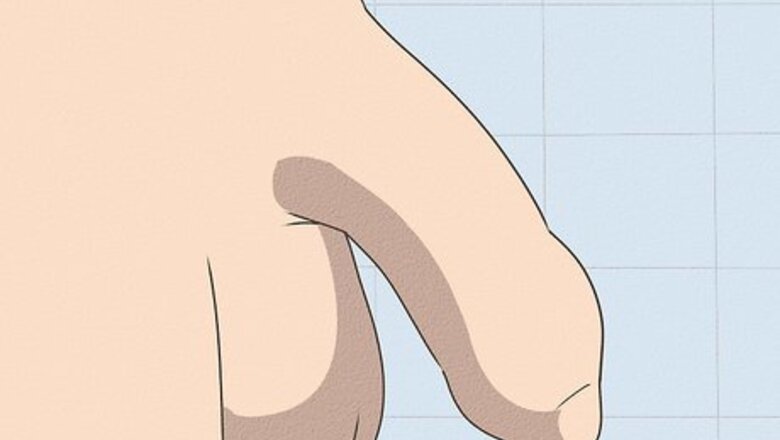
views
Making the Decision
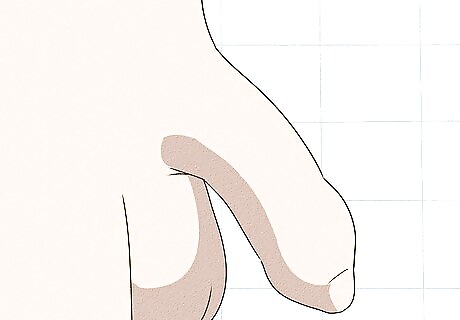
Ask yourself why you want to regrow your foreskin. Foreskin restoration won’t restore your original foreskin, but it can create new tissue around the head of your penis. There are many reasons why a man would choose to restore his foreskin. Some people do it to feel emotionally whole and believe that they’re victims of genital mutilation. Others resent not having a choice when they were circumcised as an infant. Some people restore their foreskin to increase penile sensitivity and improve sexual satisfaction. However, there isn’t enough evidence to support this claim. Whatever the reason, ask yourself if you’re ready to undertake a project that will take years to complete.

Understand how regrowth works. The most effective way to restore your foreskin without surgery is through tissue expansion. This works by pulling the skin of the penile shaft over the glans (either manually or using a device) until additional skin cells are produced and a new foreskin forms to cover the glans. Once the foreskin has expanded enough to cover the glans, some of the hidden nerve endings may be restored, which might result in increased sensitivity. Talk to your healthcare provider before you attempt tissue expansion on your own.

Do your research. There are many options for restoring the foreskin, it's just a matter of deciding which works best for you and fits into your lifestyle. For instance, a man who uses a public shower or locker room may prefer a device that can be donned and removed quickly and inconspicuously. A college student with roommates and not much money may prefer manual tugging. Do your research and carefully consider the following factors before making a decision. Cost: Although some methods cost nothing (manual tugging) others require expensive ($40 to $300) equipment. Level of commitment: How much time you're willing to invest in regrowing your foreskin can affect which method you should use. Type of activity throughout restoration time (work, exercise, etc.): Many restoration devices require a weight to be worn on the penis for hours at a time, which could be impractical if you live an active lifestyle. The amount of "extra" skin (i.e. skin folds) you currently have: Some tugging devices (such as the CAT II, DTR or TLC-X) require a certain amount of loose skin before they can be used. Therefore if you're cut very tightly, your options may be more limited, at least at first. Whether you have more shaft or mucosal skin: Shaft skin is from the circ scar line to the base of the penis and is called "outer" skin. Mucosal skin goes from the corona of the glans to the scar. Since this skin will fold against the glans and therefore be "inside" the prepuce, it's referred to as "inner" skin.
Using Manual Tugging

Understand manual tugging. Manual tugging involves using your hands to gently but firmly stretch your skin. To start, tug a few minutes a day with light tension. Slowly work up to tugging 2 to 10 minutes at a time for 1 hour or more a day. Manual tugging is the cheapest and easiest method of regrowing your foreskin, but it requires a lot of commitment as it can take a long time before any obvious results are achieved.

Find some privacy. Make sure that you have plenty of uninterrupted time to yourself during the day when you can perform the manual tugging, as it can be quite conspicuous. Your morning shower is a good time to practice tugging, as the water can help increase your grip. You can also tug while watching TV (alone) or while taking a bathroom break (if you use a stall).
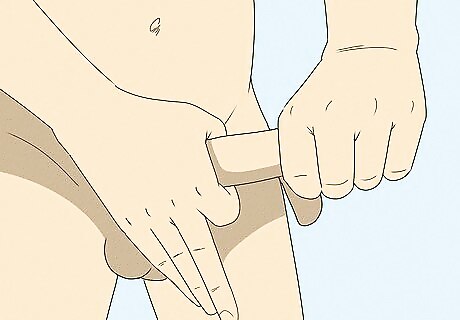
Try a basic tugging method. A good tugging technique for beginners involves making an "OK" symbol using the index finger and thumb on both hands. Use one hand to encircle the shaft of your penis near the scrotum and the other to encircle the shaft near the glans. Then gently begin pulling the skin in opposite directions. Hold the stretch for 5 to 30 seconds, then release for several seconds before repeating. This tugging method can be effective because it creates tension around the full circumference of the shaft.
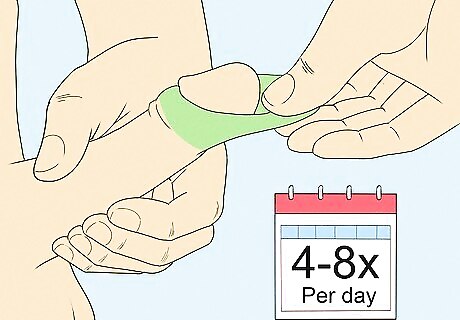
Start by tugging for an hour or two per day. Reports vary on how long you need to tug per day to get the best results. Some men claim it's necessary to tug for a minimum of six hours a day, while others report success with tugging for only one hour a day. The best thing to do is start slow until you get used to the tugging process. This will help to prevent the skin on your penis from becoming sore or irritated. To start, tug a few minutes a day with light tension. Over time, you can increase the length of time you tug for and the amount of tension you apply—if you feel it's necessary.
Using Restoration Devices

Consider using a tugging device. There are a number of tugging devices available that work by simultaneously pulling and pushing the skin on the shaft. Some of the most popular devices include: TLC tugger: With the TLC tugger, a silicone plug is placed against the glans, then the shaft skin is pulled up over the plug and held in place with a soft rubber cap. You can then attach one end of an elastic strap to the TLC and the other end around the knee or leg, to apply pulling tension. Weights can also be used. TLC-X device: Short for "TapeLess Conical eXtensible," this device is effective as it can be extended as you gain skin, making it a more long-lasting piece of equipment. Weights or straps can also be used to increase tension. It's available online for about $140. CATIIQ device: CATIIQ is short for "Constant Applied Tension II Quick." The benefit of this device is that it’s tapeless and can be attached and detached from the penis quickly and easily. DTR device: DTR is short for "Dual Tension Restorer." It's available online for about $75 to $80. MySkinClamp: Made from medical-grade stainless steel, this device functions similarly to the CATIIQ and DTR. Foreballs: These require some foreskin, which is drawn over one of the device's metal balls and taped in place. Penile Uncircumcising Device (PUD): The device is placed against the glans and the skin is drawn over the PUD and taped in place. The weight of the PUD applies tension.

Try using T-tape. T-tape is medical tape formed into a "T" shape (from a side view) which is wrapped around the foreskin and drawn forward over the glans with an elastic band. Instructions on how to make t-tape from common medical tape and how to apply it are available at RestoringForeskin.org. Comfortable and effective, this method suits many restorers and can be worn 24 hours or more, including during sleep. Drawbacks include the time it takes to apply and remove the tape, discomfort when removing, and the lack of spontaneity when amorous.
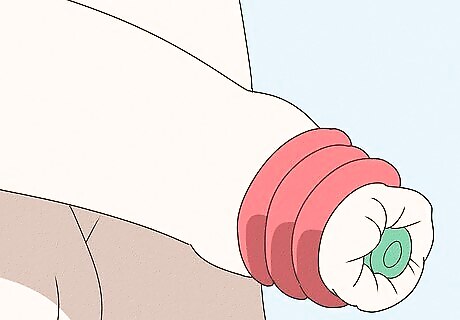
Think about using O-Rings. O-Rings are simple rubber gaskets available at most hardware stores. The major benefit of O-Rings is that they’re cheap and comfortable. With O-Rings, shaft skin is drawn over the glans and fed through the ring. The skin then naturally pulls back, which creates tension as the ring is drawn back against the glans. This method requires more loose skin than many beginning restorers have, so it is a good option once you have already developed a certain amount of loose skin.
Things to Remember

Have patience. The process of regrowing your foreskin—whether manually or using a device—takes some getting used to and may require years of time commitment. How long it takes to regain sensitivity may depend on how keratinized your glans is. Though some people report initial gains, don't expect to see immediate results. Remember, the race goes not to the swift nor the strong, but to the person who endures to the end! If you really feel that a particular tugging method isn't working for you, try switching things up. You might find that a different manual tugging technique or a new device is more effective for your body.

Don't hurt yourself. Tugging should not be painful or cause injuries of any kind, as long as it's done correctly. Focus on only tugging the skin on your shaft. Listen to your body and stop if you notice any redness, rawness, or pain. If you are experiencing pain, you may be tugging too much or tugging for too long. Be more gentle or cut back. Foreskin tugging devices may also damage your skin and your penis’ sensory nerves if used incorrectly.

Start a digital photo diary. While it sounds like a strange idea, it might help you track your progress over time. Because the process is so long, you won't notice gradual changes over months of work. But pulling up an image from last year can surprise you. Get extreme close-ups (your penis should fill the frame) from the front and each side. Use the same location and lighting conditions every time. Take one set of pictures a month and remember to date the photos. Store them on a computer and password-protect their location.
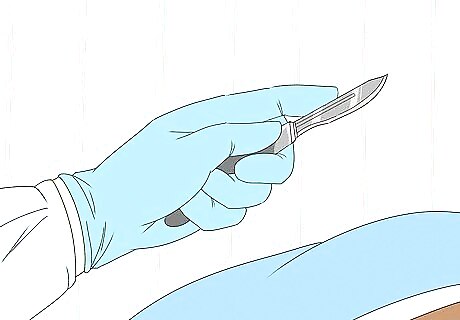
If time is an issue, you can look into surgical options. If tugging methods seem like they will take too long or require too much of a commitment, you could consider surgical restoration. Surgical foreskin restoration works by grafting skin from the scrotum or an area with similar tissue onto the end of the shaft. This new foreskin often looks different from the original skin in color and texture. Surgical restoration usually takes fewer than two hours. However, the procedure can be costly, it remains outside of mainstream medicine, and few doctors will do it.




















Comments
0 comment